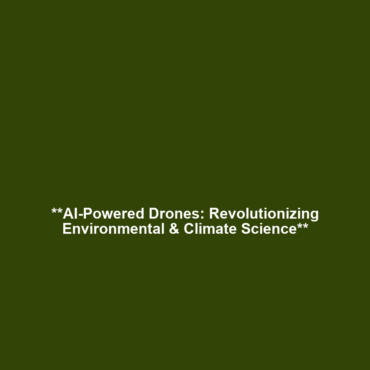Case Studies of AI-Powered Drones in Environmental and Climate Science
Introduction
In recent years, the integration of AI-powered drones in environmental and climate science has revolutionized the way researchers collect and analyze data. These advanced technologies enable efficient monitoring of ecosystems, wildlife, and climate phenomena, significantly enhancing the accuracy of scientific studies. The significance of these case studies lies in their ability to provide real-time data and insights, fostering a deeper understanding of environmental changes. This article delves into the impactful case studies of AI-powered drones in environmental and climate science, highlighting their applications, challenges, and future potential within the broader context of drones in science.
Key Concepts
The application of AI-powered drones in environmental and climate science is underpinned by several key concepts:
- Remote Sensing: Utilizing drones equipped with sensors to gather data from inaccessible or hazardous locations.
- Machine Learning: Analyzing collected data with algorithms that learn and improve from the information to make predictions.
- Geospatial Analysis: Mapping and analyzing the spatial characteristics of environmental phenomena.
These principles underscore the essential role that AI-powered drones play in advancing research in the field of drones in science.
Applications and Real-World Uses
AI-powered drones have a wide array of practical applications in environmental and climate science, including:
- Wildlife Monitoring: Drones are deployed to monitor animal populations and their behaviors without human interference.
- Forest Management: Drones are utilized to assess forest health, detect diseases, and monitor growth patterns.
- Disaster Response: In the wake of natural disasters, drones help assess damage and guide recovery efforts.
These examples demonstrate how AI-powered drones are used in environmental and climate science, effectively contributing to the broader field of drones in science.
Current Challenges
Despite the promising advancements, several challenges hinder the full potential of AI-powered drones in environmental and climate science:
- Regulatory Framework: Navigating varying laws and regulations can complicate drone operations.
- Data Management: The volume of data collected requires sophisticated tools for processing and analysis.
- Technical Limitations: Battery life, payload capacity, and weather susceptibility limit operational capabilities.
These challenges of AI-powered drones highlight the need for continued research and innovation within the realm of drones in science.
Future Research and Innovations
Looking ahead, the field of AI-powered drones in environmental and climate science is poised for substantial growth and innovation:
- Enhanced Autonomous Capabilities: Future drones may operate completely autonomously, gathering and analyzing data in real-time.
- Advanced AI Algorithms: Innovations in AI promise to improve data accuracy and predictive modeling.
- Integration with Other Technologies: Combining drone data with satellite imaging could enhance environmental monitoring.
These innovations will undoubtedly impact the future of drones in science, paving the way for more effective environmental stewardship.
Conclusion
In summary, case studies of AI-powered drones in environmental and climate science underscore their pivotal role within the broader category of drones in science. The applications extend across diverse areas, enhancing our understanding and management of environmental issues. As challenges are addressed and innovations advance, the future looks bright for the integration of AI-powered drones in scientific research. For further reading on this topic and related advances in drone technology, explore our extensive resources on drones in science.
